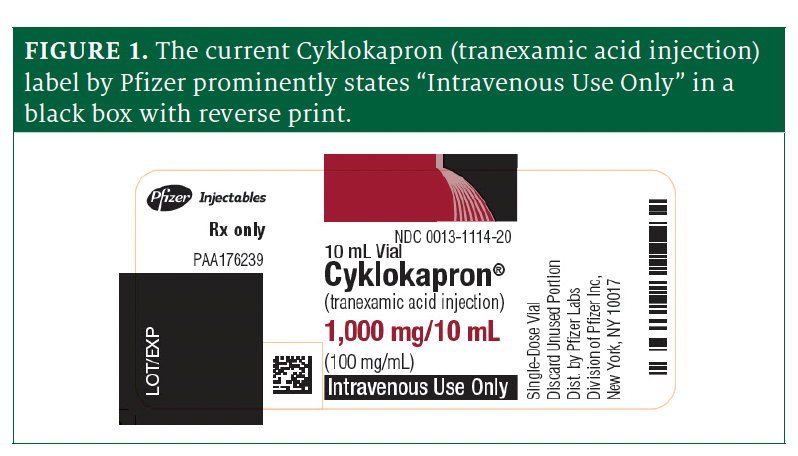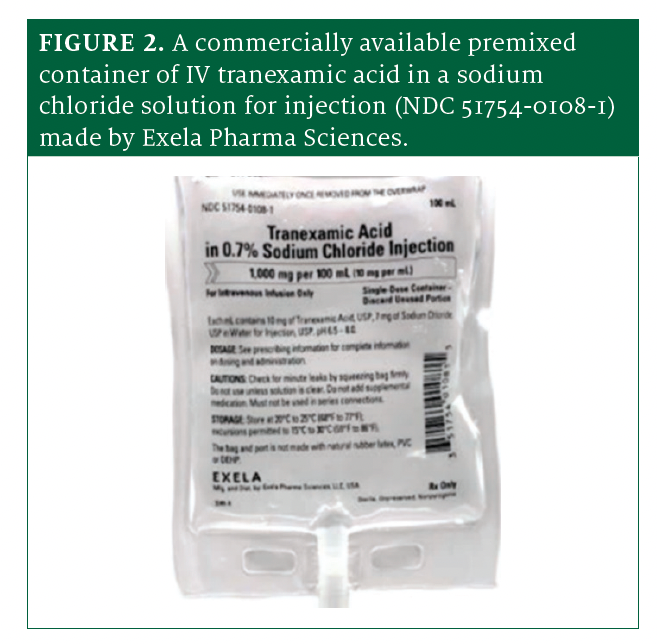Publication
Article
Pharmacy Times
Avoid Wrong-Route Errors With Tranexamic Acid
Author(s):
Although the brand name manufacturer updated the label after the FDA’s request, generic manufacturers have not all followed suit.
The institute for safe medication practices (ISMP) recently became aware of a state medical board order against a physician who inadvertently used tranexamic acid injection (Cyklokapron; Pfizer) instead of bupivacaine injection (Marcaine; Pfizer) while administering spinal anesthesia prior to knee surgery. The incident occurred in December 2020, just 3 weeks after the FDA released a warning about tranexamic acid errors.1
Image credit: Joel bubble ben | stock.adobe.com

According to the medical board’s ruling, signed on March 21, 2023, the physician was fined and reprimanded. The FDA had asked Pfizer, the product’s sponsor, to update the label on Cyklokapron to prominently state “Intravenous Use Only,” which the company did (Figure 1). Generic manufacturers should have done the same; however, not all have followed through.
Tranexamic acid is an antifibrinolytic that is used in a variety of hemorrhagic conditions to control bleeding, including postpartum hemorrhage. It works by preventing the breakdown of fibrin, thus promoting clotting. When accidentally administered via a neuraxial route, tranexamic acid injection is a potent neurotoxin with a mortality rate of about 50% and is almost always harmful to the patient. Survivors of intraspinal tranexamic acid often experience seizures, permanent neurological injury, and paraplegia.2
The ISMP has repeatedly warned against errors with tranexamic acid, including in a feature article in ISMP Medication Safety Alert! Acute Care on May 23, 2019. ISMP also published a National Alert Network warning on September 9, 2020.3
The ISMP has also received a report in which a practitioner selected and administered tranexamic acid rather than rocuronium (Zemuron; Organon USA Inc) because both vials had yellow caps. Practitioners have also reported concerns with confusing tranexamic acid and succinylcholine chloride (Quelicin; Pfizer) vials that both have red caps. In addition, outside of the United States, tranexamic acid and local anesthetics often are available in ampules with labels on clear glass that are difficult to read and can be mistaken.

To make matters worse, these drugs are often found in areas where barcode scanning may not have been implemented or is not routinely utilized (eg, perioperative areas, labor and delivery, emergency departments), so practitioners are less likely to detect mix-ups. Unfortunately, the literature has numerous reports of serious medication errors due to mix-ups between tranexamic acid and bupivacaine or ropivacaine during regional anesthesia.4
To help prevent these types of errors, consider the following risk-reduction strategies: Meet with key stakeholders (eg, anesthesiologists, certified registered nurse anesthetists, surgeons, surgical staff) to review their workflow when ordering and administering tranexamic acid.
Do not store tranexamic acid in an anesthesia tray. Determine whether tranexamic acid can be ordered through an order set and sent by the pharmacy.
Separate or sequester tranexamic acid in storage locations (eg, pharmacy, clinical areas). Consider the use of signage, shelf talkers, or other warnings, such as auxiliary labels. Avoid storing local anesthetics and tranexamic acid near one another.

To prevent misidentifying medications by viewing only the vial caps, avoid storing injectable medication vials such as tranexamic acid in an upright position, especially when stored in a bin or drawer below eye level. Store them in a way that always keeps their labels visible.
Conduct a review to identify any look-alike ampules or vials (including caps) and determine whether the risk of a mix-up will be reduced by purchasing them from different manufacturers.
Employ barcode scanning in surgical and obstetrical areas to confirm medication or solution selection prior to dispensing and administration.
When appropriate, use premixed intravenous tranexamic acid in sodium chloride injection, 1 g/100 mL (10 mg/mL) (Figure 2), which is less likely to be confused with local anesthetics in vials. Although approved to reduce or prevent hemorrhage for patients with hemophilia undergoing tooth extraction, some organizations use this product off-label to treat other forms of bleeding. However, vials of tranexamic acid may still be needed since loading doses may be required prior to infusion (or a smart infusion pump loading dose feature could be used that automatically switches to a continuous infusion once the loading dose has been delivered). In addition, the off-label use of tranexamic acid topically and locally for hemorrhage may still require vials to be available.
If not using commercially available premixed containers of tranexamic acid (eg, during drug shortages), consider pharmacy-prepared intravenous infusions for surgical areas, to avoid confusion with vials of other medications.
About the Author
Michael J. Gaunt, PharmD, is a senior director of error reporting programs and editor at the Institute for Safe Medication Practices (ISMP) in Horsham, Pennsylvania. He also serves as the editor of the monthly ISMP Medication Safety Alert! Community/Ambulatory Care newsletter.
References
- FDA alerts healthcare professionals about the risk of medication errors with tranexamic acid injection resulting in inadvertent intrathecal (spinal) injection. US Food and Drug Administration. December 3, 2020. Accessed September 13, 2023. www.fda.gov/drugs/drug-safety-and-availability/fda-alerts-healthcare-professionals-about-risk-medication-errors-tranexamic-acid-injection-resulting
- Palanisamy A, Kinsella SM. Spinal tranexamic acid – a new killer in town. Anaesthesia. 2019;74(7):831-833. doi:10.1111/anae.14632
- Dangerous wrong-route errors with tranexamic acid. Institute for Safe Medication Practices. September 9, 2020. Accessed September 13, 2023.https://www.ismp.org/alerts/dangerous-wrong-route-errors-tranexamic-acid
- Risk of medication errors with tranexamic acid injection resulting in inadvertent intrathecal injection. World Health Organization. March 16, 2022. Accessed September 13, 2023. https://www.who.int/news/item/16-03-2022-risk-of-medication-errors-with-tranexamic-acid-injection-resulting-in-inadvertent-intrathecal-injection

Newsletter
Stay informed on drug updates, treatment guidelines, and pharmacy practice trends—subscribe to Pharmacy Times for weekly clinical insights.





